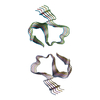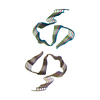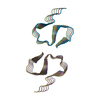+ Open data
Open data
- Basic information
Basic information
| Entry | Database: PDB / ID: 8olg | ||||||||||||||||||
|---|---|---|---|---|---|---|---|---|---|---|---|---|---|---|---|---|---|---|---|
| Title | DI2 Abeta fibril from tg-SwDI mouse | ||||||||||||||||||
 Components Components | Amyloid-beta protein 42 Amyloid beta Amyloid beta | ||||||||||||||||||
 Keywords Keywords | PROTEIN FIBRIL /  Amyloid fibril Amyloid fibril | ||||||||||||||||||
| Function / homology |  Function and homology information Function and homology informationregulation of epidermal growth factor-activated receptor activity / signaling receptor activator activity / cytosolic mRNA polyadenylation / collateral sprouting in absence of injury / microglia development / regulation of synapse structure or activity / Formyl peptide receptors bind formyl peptides and many other ligands / axo-dendritic transport / synaptic assembly at neuromuscular junction / smooth endoplasmic reticulum calcium ion homeostasis ...regulation of epidermal growth factor-activated receptor activity / signaling receptor activator activity / cytosolic mRNA polyadenylation / collateral sprouting in absence of injury / microglia development / regulation of synapse structure or activity / Formyl peptide receptors bind formyl peptides and many other ligands / axo-dendritic transport / synaptic assembly at neuromuscular junction / smooth endoplasmic reticulum calcium ion homeostasis / axon midline choice point recognition / astrocyte activation involved in immune response / regulation of spontaneous synaptic transmission /  regulation of Wnt signaling pathway / mating behavior / positive regulation of amyloid fibril formation / regulation of Wnt signaling pathway / mating behavior / positive regulation of amyloid fibril formation /  ciliary rootlet / Lysosome Vesicle Biogenesis / ciliary rootlet / Lysosome Vesicle Biogenesis /  PTB domain binding / Golgi-associated vesicle / neuron remodeling / Insertion of tail-anchored proteins into the endoplasmic reticulum membrane / : / Deregulated CDK5 triggers multiple neurodegenerative pathways in Alzheimer's disease models / presynaptic active zone / nuclear envelope lumen / modulation of excitatory postsynaptic potential / suckling behavior / COPII-coated ER to Golgi transport vesicle / dendrite development / PTB domain binding / Golgi-associated vesicle / neuron remodeling / Insertion of tail-anchored proteins into the endoplasmic reticulum membrane / : / Deregulated CDK5 triggers multiple neurodegenerative pathways in Alzheimer's disease models / presynaptic active zone / nuclear envelope lumen / modulation of excitatory postsynaptic potential / suckling behavior / COPII-coated ER to Golgi transport vesicle / dendrite development /  smooth endoplasmic reticulum / smooth endoplasmic reticulum /  regulation of NMDA receptor activity / TRAF6 mediated NF-kB activation / negative regulation of long-term synaptic potentiation / Advanced glycosylation endproduct receptor signaling / neuromuscular process controlling balance / regulation of presynapse assembly / The NLRP3 inflammasome / intracellular copper ion homeostasis / transition metal ion binding / regulation of multicellular organism growth / negative regulation of neuron differentiation / ECM proteoglycans / spindle midzone / positive regulation of T cell migration / regulation of NMDA receptor activity / TRAF6 mediated NF-kB activation / negative regulation of long-term synaptic potentiation / Advanced glycosylation endproduct receptor signaling / neuromuscular process controlling balance / regulation of presynapse assembly / The NLRP3 inflammasome / intracellular copper ion homeostasis / transition metal ion binding / regulation of multicellular organism growth / negative regulation of neuron differentiation / ECM proteoglycans / spindle midzone / positive regulation of T cell migration /  Purinergic signaling in leishmaniasis infection / positive regulation of calcium-mediated signaling / forebrain development / regulation of peptidyl-tyrosine phosphorylation / positive regulation of chemokine production / Purinergic signaling in leishmaniasis infection / positive regulation of calcium-mediated signaling / forebrain development / regulation of peptidyl-tyrosine phosphorylation / positive regulation of chemokine production /  clathrin-coated pit / clathrin-coated pit /  Notch signaling pathway / cholesterol metabolic process / positive regulation of G2/M transition of mitotic cell cycle / positive regulation of protein metabolic process / ionotropic glutamate receptor signaling pathway / neuron projection maintenance / positive regulation of glycolytic process / extracellular matrix organization / positive regulation of mitotic cell cycle / response to interleukin-1 / Notch signaling pathway / cholesterol metabolic process / positive regulation of G2/M transition of mitotic cell cycle / positive regulation of protein metabolic process / ionotropic glutamate receptor signaling pathway / neuron projection maintenance / positive regulation of glycolytic process / extracellular matrix organization / positive regulation of mitotic cell cycle / response to interleukin-1 /  axonogenesis / adult locomotory behavior / trans-Golgi network membrane / dendritic shaft / locomotory behavior / platelet alpha granule lumen / positive regulation of peptidyl-threonine phosphorylation / axonogenesis / adult locomotory behavior / trans-Golgi network membrane / dendritic shaft / locomotory behavior / platelet alpha granule lumen / positive regulation of peptidyl-threonine phosphorylation /  learning / positive regulation of interleukin-1 beta production / learning / positive regulation of interleukin-1 beta production /  central nervous system development / positive regulation of long-term synaptic potentiation / astrocyte activation / endosome lumen / central nervous system development / positive regulation of long-term synaptic potentiation / astrocyte activation / endosome lumen /  Post-translational protein phosphorylation / synapse organization / microglial cell activation / regulation of long-term neuronal synaptic plasticity / positive regulation of JNK cascade / TAK1-dependent IKK and NF-kappa-B activation / Post-translational protein phosphorylation / synapse organization / microglial cell activation / regulation of long-term neuronal synaptic plasticity / positive regulation of JNK cascade / TAK1-dependent IKK and NF-kappa-B activation /  neuromuscular junction / neuromuscular junction /  visual learning / serine-type endopeptidase inhibitor activity / recycling endosome / visual learning / serine-type endopeptidase inhibitor activity / recycling endosome /  cognition / positive regulation of inflammatory response / positive regulation of interleukin-6 production / neuron cellular homeostasis / Golgi lumen / cognition / positive regulation of inflammatory response / positive regulation of interleukin-6 production / neuron cellular homeostasis / Golgi lumen /  endocytosis / positive regulation of non-canonical NF-kappaB signal transduction / Regulation of Insulin-like Growth Factor (IGF) transport and uptake by Insulin-like Growth Factor Binding Proteins (IGFBPs) / neuron projection development / cellular response to amyloid-beta / positive regulation of DNA-binding transcription factor activity / G2/M transition of mitotic cell cycle / cell-cell junction / endocytosis / positive regulation of non-canonical NF-kappaB signal transduction / Regulation of Insulin-like Growth Factor (IGF) transport and uptake by Insulin-like Growth Factor Binding Proteins (IGFBPs) / neuron projection development / cellular response to amyloid-beta / positive regulation of DNA-binding transcription factor activity / G2/M transition of mitotic cell cycle / cell-cell junction /  synaptic vesicle / positive regulation of tumor necrosis factor production / synaptic vesicle / positive regulation of tumor necrosis factor production /  regulation of translation regulation of translationSimilarity search - Function | ||||||||||||||||||
| Biological species |   Homo sapiens (human) Homo sapiens (human) | ||||||||||||||||||
| Method |  ELECTRON MICROSCOPY / helical reconstruction / ELECTRON MICROSCOPY / helical reconstruction /  cryo EM / Resolution: 4.2 Å cryo EM / Resolution: 4.2 Å | ||||||||||||||||||
 Authors Authors | Zielinski, M. / Peralta Reyes, F.S. / Gremer, L. / Schemmert, S. / Frieg, B. / Willuweit, A. / Donner, L. / Elvers, M. / Nilsson, L.N.G. / Syvanen, S. ...Zielinski, M. / Peralta Reyes, F.S. / Gremer, L. / Schemmert, S. / Frieg, B. / Willuweit, A. / Donner, L. / Elvers, M. / Nilsson, L.N.G. / Syvanen, S. / Sehlin, D. / Ingelsson, M. / Willbold, D. / Schroeder, G.F. | ||||||||||||||||||
| Funding support |  Germany, Germany,  Sweden, 5items Sweden, 5items
| ||||||||||||||||||
 Citation Citation |  Journal: Nat Neurosci / Year: 2023 Journal: Nat Neurosci / Year: 2023Title: Cryo-EM of Aβ fibrils from mouse models find tg-APP fibrils resemble those found in patients with sporadic Alzheimer's disease. Authors: Mara Zielinski / Fernanda S Peralta Reyes / Lothar Gremer / Sarah Schemmert / Benedikt Frieg / Luisa U Schäfer / Antje Willuweit / Lili Donner / Margitta Elvers / Lars N G Nilsson / Stina ...Authors: Mara Zielinski / Fernanda S Peralta Reyes / Lothar Gremer / Sarah Schemmert / Benedikt Frieg / Luisa U Schäfer / Antje Willuweit / Lili Donner / Margitta Elvers / Lars N G Nilsson / Stina Syvänen / Dag Sehlin / Martin Ingelsson / Dieter Willbold / Gunnar F Schröder /     Abstract: The use of transgenic mice displaying amyloid-β (Aβ) brain pathology has been essential for the preclinical assessment of new treatment strategies for Alzheimer's disease. However, the properties ...The use of transgenic mice displaying amyloid-β (Aβ) brain pathology has been essential for the preclinical assessment of new treatment strategies for Alzheimer's disease. However, the properties of Aβ in such mice have not been systematically compared to Aβ in the brains of patients with Alzheimer's disease. Here, we determined the structures of nine ex vivo Aβ fibrils from six different mouse models by cryogenic-electron microscopy. We found novel Aβ fibril structures in the APP/PS1, ARTE10 and tg-SwDI models, whereas the human type II filament fold was found in the ARTE10, tg-APP and APP23 models. The tg-APP mice showed an Aβ fibril whose structure resembles the human type I filament found in patients with sporadic Alzheimer's disease. A detailed assessment of the Aβ fibril structure is key to the selection of adequate mouse models for the preclinical development of novel plaque-targeting therapeutics and positron emission tomography imaging tracers in Alzheimer's disease. | ||||||||||||||||||
| History |
|
- Structure visualization
Structure visualization
| Structure viewer | Molecule:  Molmil Molmil Jmol/JSmol Jmol/JSmol |
|---|
- Downloads & links
Downloads & links
- Download
Download
| PDBx/mmCIF format |  8olg.cif.gz 8olg.cif.gz | 42.9 KB | Display |  PDBx/mmCIF format PDBx/mmCIF format |
|---|---|---|---|---|
| PDB format |  pdb8olg.ent.gz pdb8olg.ent.gz | 29.5 KB | Display |  PDB format PDB format |
| PDBx/mmJSON format |  8olg.json.gz 8olg.json.gz | Tree view |  PDBx/mmJSON format PDBx/mmJSON format | |
| Others |  Other downloads Other downloads |
-Validation report
| Arichive directory |  https://data.pdbj.org/pub/pdb/validation_reports/ol/8olg https://data.pdbj.org/pub/pdb/validation_reports/ol/8olg ftp://data.pdbj.org/pub/pdb/validation_reports/ol/8olg ftp://data.pdbj.org/pub/pdb/validation_reports/ol/8olg | HTTPS FTP |
|---|
-Related structure data
| Related structure data |  16957MC  8ol2C  8ol3C  8ol5C  8ol6C  8ol7C  8olnC  8oloC  8olqC M: map data used to model this data C: citing same article ( |
|---|---|
| Similar structure data | Similarity search - Function & homology  F&H Search F&H Search |
- Links
Links
- Assembly
Assembly
| Deposited unit | 
|
|---|---|
| 1 |
|
- Components
Components
| #1: Protein/peptide |  Amyloid beta / Abeta42 / Beta-APP42 Amyloid beta / Abeta42 / Beta-APP42Mass: 4518.117 Da / Num. of mol.: 5 Source method: isolated from a genetically manipulated source Source: (gene. exp.)   Homo sapiens (human) / Gene: APP, A4, AD1 / Production host: Homo sapiens (human) / Gene: APP, A4, AD1 / Production host:   Mus musculus (house mouse) / Strain (production host): tg-SwDI / References: UniProt: P05067 Mus musculus (house mouse) / Strain (production host): tg-SwDI / References: UniProt: P05067 |
|---|
-Experimental details
-Experiment
| Experiment | Method:  ELECTRON MICROSCOPY ELECTRON MICROSCOPY |
|---|---|
| EM experiment | Aggregation state: FILAMENT / 3D reconstruction method: helical reconstruction |
- Sample preparation
Sample preparation
| Component | Name: Amyloid fibril of amyloid-beta / Type: COMPLEX / Entity ID: all / Source: NATURAL |
|---|---|
| Molecular weight | Value: 20 kDa/nm / Experimental value: NO |
| Source (natural) | Organism:   Homo sapiens (human) Homo sapiens (human) |
| Source (recombinant) | Organism:   Mus musculus (house mouse) Mus musculus (house mouse) |
| Buffer solution | pH: 7.4 |
| Specimen | Embedding applied: NO / Shadowing applied: NO / Staining applied : NO / Vitrification applied : NO / Vitrification applied : YES : YES |
Vitrification | Instrument: FEI VITROBOT MARK IV / Cryogen name: ETHANE |
- Electron microscopy imaging
Electron microscopy imaging
| Experimental equipment |  Model: Titan Krios / Image courtesy: FEI Company |
|---|---|
| Microscopy | Model: TFS KRIOS |
| Electron gun | Electron source : :  FIELD EMISSION GUN / Accelerating voltage: 300 kV / Illumination mode: FLOOD BEAM FIELD EMISSION GUN / Accelerating voltage: 300 kV / Illumination mode: FLOOD BEAM |
| Electron lens | Mode: BRIGHT FIELD Bright-field microscopy / Nominal defocus max: 3000 nm / Nominal defocus min: 500 nm Bright-field microscopy / Nominal defocus max: 3000 nm / Nominal defocus min: 500 nm |
| Image recording | Electron dose: 40.1 e/Å2 / Film or detector model: FEI FALCON IV (4k x 4k) / Num. of grids imaged: 1 / Num. of real images: 25662 |
- Processing
Processing
| Software | Name: PHENIX / Version: 1.20.1_4487: / Classification: refinement | ||||||||||||||||||||||||
|---|---|---|---|---|---|---|---|---|---|---|---|---|---|---|---|---|---|---|---|---|---|---|---|---|---|
| EM software |
| ||||||||||||||||||||||||
CTF correction | Type: PHASE FLIPPING AND AMPLITUDE CORRECTION | ||||||||||||||||||||||||
| Helical symmerty | Angular rotation/subunit: -2.95 ° / Axial rise/subunit: 4.63 Å / Axial symmetry: C1 | ||||||||||||||||||||||||
3D reconstruction | Resolution: 4.2 Å / Resolution method: FSC 0.143 CUT-OFF / Num. of particles: 37937 / Algorithm: FOURIER SPACE / Symmetry type: HELICAL | ||||||||||||||||||||||||
| Refine LS restraints |
|
 Movie
Movie Controller
Controller











 PDBj
PDBj














